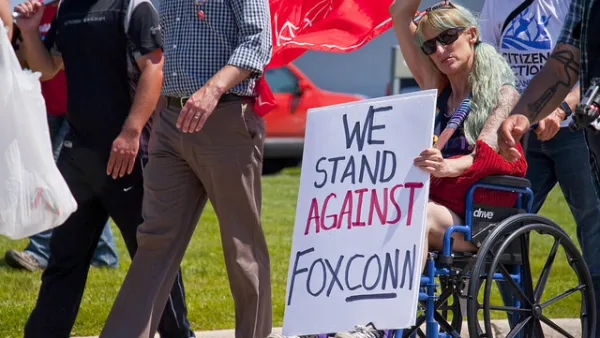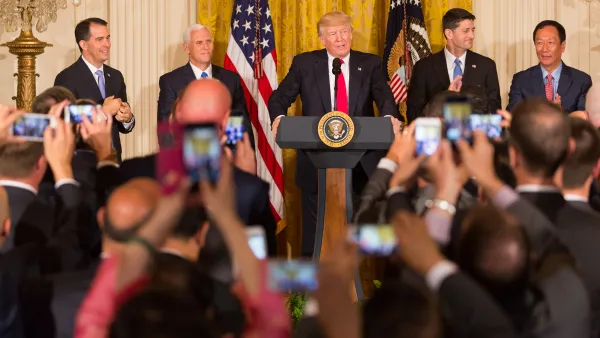Wisconsin taxpayer will be paying the bill for the deal to bring Foxconn to Racine "for decades, if not generations, to come."

Bruce Murphy devotes feature-length attention to the evolution of the deal that brought a massive Foxconn manufacturing plant to Racine County, in southeastern Wisconsin.
The original deal, written on the back of a napkin, offered Foxconn $3.1 billion, "far and away the largest in Wisconsin history and the largest government handout to a foreign company ever given in America," writes Murphy. Since the deal was announced in July 2017, that subsidy has ballooned to $4.1 billion.
But what seemed so simple on a napkin has turned out to be far more complicated and messy in real life. As the size of the subsidy has steadily increased to a jaw-dropping $4.1 billion, Foxconn has repeatedly changed what it plans to do, raising doubts about the number of jobs it will create. Instead of the promised Generation 10.5 plant, Foxconn now says it will build a much smaller Gen 6 plant, which would require one-third of the promised investment, although the company insists it will eventually hit the $10 billion investment target. And instead of a factory of workers building panels for 75-inch TVs, Foxconn executives now say the goal is to build “ecosystem” of buzzwords called “AI 8K+5G” with most of the manufacturing done by robots.
The article documents that growing size the subsidies offered in the deal, as well as the contraction of the new facility promised in return for the subsidies. That's only part of the story, however, as concerns grow about the environmental externalities of the future Foxconn plant. Wisconsin has exempted Foxconn from the state's environmental rules, "allowing it to discharge materials into wetlands and reroute streams during construction and operation" and also "[exempting] the company from doing an Environmental Impact Statement." Lee Bergquist reported in March that the plant "would rank among the highest in southeastern Wisconsin for pollutants that create smog, also known as ozone pollution."
All of the debate and concern over the size of the state's subsidy to Foxconn, and the reality of what it might get in return, is in context of the impending gubernatorial election, in which Gov. Scott Walker is seeking a third term in office.
FULL STORY: WISCONSIN’S $4.1 BILLION FOXCONN BOONDOGGLE

National Parks Layoffs Will Cause Communities to Lose Billions
Thousands of essential park workers were laid off this week, just before the busy spring break season.

Retro-silient?: America’s First “Eco-burb,” The Woodlands Turns 50
A master-planned community north of Houston offers lessons on green infrastructure and resilient design, but falls short of its founder’s lofty affordability and walkability goals.

Delivering for America Plan Will Downgrade Mail Service in at Least 49.5 Percent of Zip Codes
Republican and Democrat lawmakers criticize the plan for its disproportionate negative impact on rural communities.

Test News Post 1
This is a summary

Test News Headline 46
Test for the image on the front page.

Balancing Bombs and Butterflies: How the National Guard Protects a Rare Species
The National Guard at Fort Indiantown Gap uses GIS technology and land management strategies to balance military training with conservation efforts, ensuring the survival of the rare eastern regal fritillary butterfly.
Urban Design for Planners 1: Software Tools
This six-course series explores essential urban design concepts using open source software and equips planners with the tools they need to participate fully in the urban design process.
Planning for Universal Design
Learn the tools for implementing Universal Design in planning regulations.
EMC Planning Group, Inc.
Planetizen
Planetizen
Mpact (formerly Rail~Volution)
Great Falls Development Authority, Inc.
HUDs Office of Policy Development and Research
NYU Wagner Graduate School of Public Service




























